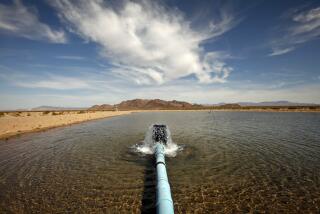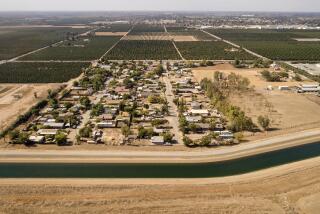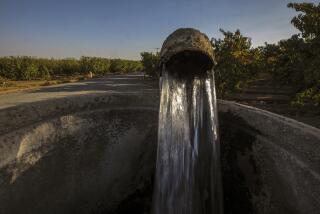How a rich water district beat the federal government in a secret deal

The San Luis Reservoir near Los Banos, shown in 2014, is part of the Central Valley Project and supplies water to the giant Westlands Water District.
Clout can be defined in many ways. In California’s parched Central Valley farmlands, it’s the ability to secure water.
By that measure, the giant Westlands Water District has just set a whole new standard. In a legal settlement signed Wednesday with federal officials following lengthy negotiations, the 600,000-acre district secured a water supply for its members’ almond and pistachio trees and other crops in perpetuity, immunizing it from many of the cutbacks that may afflict other water users as climate change and other conditions reduce the reliability of California’s overall water supply. And it was all done in secret.
Although outlines of the settlement have circulated in Washington for months, environmental advocates and several Northern California members of Congress say the details were kept confidential until the deal was signed by Westlands and the Department of Justice, and filed as a fait accompli in federal court — including draft legislation shortly to be submitted to Congress.
“This was all done without any visibility or transparency,” says Rep. Jerry McNerney (D-Stockton), whose district includes part of the Sacramento-San Joaquin Delta, which is heavily affected by water deliveries to Westlands.
Many of the deal’s elements are “contrary to what we should be doing in the delta,” and it is “inexplicable” that they would be reached in secret, says Kate Poole, senior attorney for the water program of the Natural Resources Defense Council in San Francisco.
They’re right. The deal is extraordinarily advantageous for Westlands.
It extinguishes a debt of roughly $350 million owed to the federal government, covering the district’s share of the cost of the Central Valley Project, which brings irrigation water to its landholders. It transfers the responsibility for building a system to safely dispose of toxic agricultural waste from the government to the district, though without imposing explicit anti-pollution benchmarks. It transfers what could be hundreds of millions of dollars’ worth of federally funded water infrastructure to the district, without compensation or even a formal appraisal.
That handover is “a disturbing dismemberment of our ... federal patrimony,” says Antonio Rossmann, a Berkeley water law expert.
To many critics, what’s worst about the deal is that it transforms Westlands’ 25-year contract for federal water into a permanent, non-reviewable right to as much as 895,000 acre-feet a year. That’s 150% of the annual usage of the city of Los Angeles. The deal prevents federal or state officials from ever diverting Westlands’ water to what might emerge as more beneficial uses in the future.
Any effort to craft a statewide water policy in an era of increasing demand and shrinking supply will run into the roadblock of Westlands’ enormous perpetual entitlement. “Obviously our hydrology is changing considerably,” says Poole. “Who knows what competing uses might look like in 20 or 25 years?”
How did Westlands, the nation’s largest public water district, achieve its ends? “It’s money and lawyers,” says Rep. Jared Huffman (D-San Rafael), a Westlands critic. Westlands spends heavily on lobbyists — $2.3 million in Washington since 2012, and $576,000 in Sacramento. Lawyers for the district or its landholders have tied up federal officials in court for decades over their contention that the government is obligated to provide drainage for farm runoff.
Westlands General Manager Tom Birmingham calls the new deal a “reasonable solution” to the intricate dispute. He says taxpayers gain by being relieved of a court-mandated obligation to build the drainage system, estimated by Westlands at $3.5 billion.
The roots of the dispute date back to the original 1960 plan to bring water to the west valley via the federal Central Valley Project. The lack of drainage was glossed over in the rush to develop the land with irrigation. A project was launched in the 1970s to build a drain carrying contaminated runoff to the delta and thence to San Francisco Bay. But it was built only as far as the Kesterson National Wildlife Refuge, where in 1983 scientists discovered that the toxic selenium-laced wastewater was producing grotesque deformities in nesting waterfowl. The drain was plugged, but the irrigation continued.
Environmentalists and Interior Department scientists eventually concluded that the only truly certain way to eliminate the pollution was to shut down its source, by removing as much as two-thirds of Westlands’ 600,000 acres from cultivation. But in 2007 the Reclamation Bureau settled on a multibillion-dollar plan to retire only about 200,000 acres and treat the effluent with evaporation ponds and other technologies.
Although the cost would be repaid over decades by Westlands, interest-free, Reclamation didn’t have the money to front for construction. The new settlement lets Westlands take over the task, but requires the district to retire only 100,000 acres, most of which has already been retired or is lying fallow.
Another aspect of the settlement that alarms critics is that it relieves Westlands farms from the federal limit of 960 acres for farms eligible to receive federal water at subsidized prices. Allowing Westland farms to consolidate would carry the district further from the ideal of small family farm agriculture that was used to justify the federal irrigation project in the 1950s and 1960s.
Westlands still promotes itself as a haven of mom-and-pop family farms. The business structure “for today’s family farmers in Westlands is likely to have a mom as its vice president and her child as its treasurer,” the district declared in a full-page ad in The Times last year, placed in response to a critical news article.
But many of the family farms in Westlands are in fact huge enterprises, including such leading California agribusinesses as Woolf Enterprises and Harris Farms. Although Westlands has claimed to encompass about 700 farms averaging 710 acres, a 2011 study by researchers from the University of California and the Colorado School of Mines concluded that many were grouped via family trusts and other “common ownership” into about 350 networked operations.
“There isn’t any question that there are large farms in Westlands,” Birmingham acknowledges, though he adds: “Even the large farms are family farms in every sense of the word.”
Westlands’ critics link the mega-farms to the failure of the Central Valley Project to bring true prosperity to the farm region. Fresno County, where most of the district lies, is one of the poorest in the nation, arguably because the bounty of agricultural profits has been concentrated among a small number of farm-owning families. Removing the acreage limitation will allow those big farms to get bigger.
The Westlands settlement is exactly the wrong approach to the West’s water issues at the wrong time. It’s a narrow response to litigation, benefiting a few thousand farmers at most, when what the water crisis requires are comprehensive solutions serving all stakeholders and the public at large.
The secrecy of the deal-making sets an appalling precedent. Huffman and McNerney say they’ll challenge the deal when the enabling legislation reaches Capitol Hill, and everyone with an interest in sane water policy — and that’s everyone in California, the West, indeed the country — should be on their side. Congress should kill this deal and send negotiators back to the table — to do their work in public view.
Michael Hiltzik’s column appears every Sunday. His new book is “Big Science: Ernest Lawrence and the Invention that Launched the Military-Industrial Complex.” Read his blog, the Economy Hub, at latimes.com/business/hiltzik, reach him at mhiltzik@latimes.com, check out facebook.com/hiltzik and follow @hiltzikm on Twitter.







